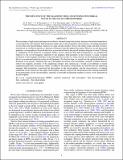Files in this item
The influence of the magnetic field on running penumbral waves in the solar chromosphere
Item metadata
| dc.contributor.author | Jess, David | |
| dc.contributor.author | Reznikova, V | |
| dc.contributor.author | Van Doorsselaere, Tom | |
| dc.contributor.author | Mackay, Duncan Hendry | |
| dc.contributor.author | Keys, Peter | |
| dc.date.accessioned | 2014-08-14T11:31:03Z | |
| dc.date.available | 2014-08-14T11:31:03Z | |
| dc.date.issued | 2013-12-03 | |
| dc.identifier | 102317173 | |
| dc.identifier | 5e2de3c0-de35-4ce3-94ec-7715eb804553 | |
| dc.identifier | 84889771957 | |
| dc.identifier.citation | Jess , D , Reznikova , V , Van Doorsselaere , T , Mackay , D H & Keys , P 2013 , ' The influence of the magnetic field on running penumbral waves in the solar chromosphere ' , Astrophysical Journal , vol. 779 , no. 2 , 168 . https://doi.org/10.1088/0004-637X/779/2/168 | en |
| dc.identifier.issn | 0004-637X | |
| dc.identifier.other | ORCID: /0000-0001-6065-8531/work/58055449 | |
| dc.identifier.uri | https://hdl.handle.net/10023/5155 | |
| dc.description | D.B.J. acknowledges the European Commission and the Fonds Wetenschappelijk Onderzoek (FWO) for the award of a Marie Curie Pegasus Fellowship during which this work was initiated, in addition to the UK Science and Technology Facilities Council (STFC) for the award of an Ernest Rutherford Fellowship which allowed the completion of this project. The research carried out by V.E.R. is partly supported by grant MC FP7-PEOPLE-2011-IRSES-295272. T.V.D. acknowledges funding from the Odysseus Programme of the FWO Vlaanderen and from the EU's 7th Framework Programme as an ERG with grant number 276808. P.H.K. and D.H.M. are grateful to STFC for research support. This research has been funded by the Interuniversity Attraction Poles Programme initiated by the Belgian Science Policy Office (IAP P7/08 CHARM). | en |
| dc.description.abstract | We use images of high spatial and temporal resolution, obtained using both ground- and space-based instrumentation, to investigate the role magnetic field inclination angles play in the propagation characteristics of running penumbral waves in the solar chromosphere. Analysis of a near-circular sunspot, close to the center of the solar disk, reveals a smooth rise in oscillatory period as a function of distance from the umbral barycenter. However, in one directional quadrant, corresponding to the north direction, a pronounced kink in the period-distance diagram is found. Utilizing a combination of the inversion of magnetic Stokes vectors and force-free field extrapolations, we attribute this behavior to the cut-off frequency imposed by the magnetic field geometry in this location. A rapid, localized inclination of the magnetic field lines in the north direction results in a faster increase in the dominant periodicity due to an accelerated reduction in the cut-off frequency. For the first time, we reveal how the spatial distribution of dominant wave periods, obtained with one of the highest resolution solar instruments currently available, directly reflects the magnetic geometry of the underlying sunspot, thus opening up a wealth of possibilities in future magnetohydrodynamic seismology studies. In addition, the intrinsic relationships we find between the underlying magnetic field geometries connecting the photosphere to the chromosphere, and the characteristics of running penumbral waves observed in the upper chromosphere, directly supports the interpretation that running penumbral wave phenomena are the chromospheric signature of upwardly propagating magneto-acoustic waves generated in the photosphere. | |
| dc.format.extent | 11 | |
| dc.format.extent | 2657416 | |
| dc.language.iso | eng | |
| dc.relation.ispartof | Astrophysical Journal | en |
| dc.subject | Magnetohydrodynamics (MHD) | en |
| dc.subject | Methods: numerical | en |
| dc.subject | Sun: atmosphere | en |
| dc.subject | Sun: chromosphere | en |
| dc.subject | Sun: oscillations | en |
| dc.subject | Sun: photosphere | en |
| dc.subject | QB Astronomy | en |
| dc.subject.lcc | QB | en |
| dc.title | The influence of the magnetic field on running penumbral waves in the solar chromosphere | en |
| dc.type | Journal article | en |
| dc.contributor.sponsor | Science & Technology Facilities Council | en |
| dc.contributor.institution | University of St Andrews. Applied Mathematics | en |
| dc.identifier.doi | 10.1088/0004-637X/779/2/168 | |
| dc.description.status | Peer reviewed | en |
| dc.identifier.grantnumber | ST/K000950/1 | en |
This item appears in the following Collection(s)
Items in the St Andrews Research Repository are protected by copyright, with all rights reserved, unless otherwise indicated.

